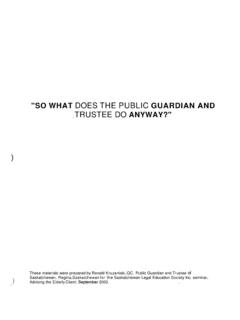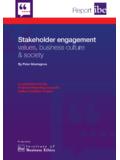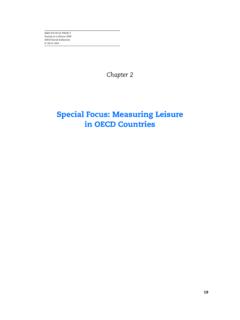Transcription of DIVISION OF FAMILY PROPERTY - Law Society of …
1 DIVISION OF FAMILY PROPERTY . Gregory G. Walen, and Matthew R. Lewans Scharfstein Gibbings Walen & Fisher 420, 128 - 4th Avenue South Saskatoon, Saskatchewan S7K 1M8. Revised June 2005. Not to be used or reproduced without permission - Saskatchewan Legal Education Society Inc. Saskatchewan: Bar Admission Program i FAMILY Law - DIVISION of FAMILY PROPERTY TABLE OF CONTENTS. I. INTRODUCTION .. 1. II. THE FAMILY PROPERTY ACT .. 1. A. APPLICATION .. 1. 1. Definition of Spouse .. 1. a. Is Cohabiting or Has Cohabited? .. 3. b. Cohabiting as Spouses .. 6. c. Continuously .. 8. B. POSSESSION ORDERS AND ORDERS FOR PRESERVATION .. 13. 1. Possession Orders .. 13. 2. Orders for Preservation.
2 16. C. DIVISION OF FAMILY PROPERTY .. 17. 1. Methodology .. 17. 2. PROPERTY Subject to the Act .. 18. 3. Valuation of 19. a. PROPERTY in General .. 22. b. Business Valuation .. 23. c. Pension Valuation .. 25. 4. Exemptions .. 27. a. PROPERTY in General .. 27. b. PROPERTY Subject to an Interspousal Contract .. 30. 5. FAMILY Home and Household 33. 6. Exceptions and Equitable 36. 7. Applications on Death of 53. Revised June 2005. Not to be used or reproduced without permission - Saskatchewan Legal Education Society Inc. Saskatchewan: Bar Admission Program 1. FAMILY Law - DIVISION of FAMILY PROPERTY I. INTRODUCTION. The disruptive economic consequences associated with marital breakdown have prompted both Parliament and the Provincial Legislatures to develop statutory frameworks in an attempt to ameliorate these problems.
3 More specifically, the issue of dividing PROPERTY accumulated during the relationship has been addressed in this jurisdiction through The FAMILY PROPERTY Act. 1 The purpose of this paper is to provide an overview of the fundamental issues addressed through this piece of legislation in a chronological fashion. This paper is intended to be an aid to legal research, not in substitution for it. II. THE FAMILY PROPERTY ACT. A. APPLICATION. 1. Definition of Spouse . Interpretation 2(1) In this Act: .. spouse means either of two persons who: (a) at the time an application is made pursuant to this Act, is legally married to the other or is married to the other by a marriage that is voidable and has not been voided by a judgment of nullity; or (b) has, in good faith, gone through a form of statutory marriage with the other that is void, where they are cohabiting or have cohabited within the two years preceding the making of an application pursuant to this Act.
4 (c) is cohabiting or has cohabited with the other person as spouses continuously for a period of not less than two years;. and includes: (d) a surviving spouse who continues or commences an application pursuant to section 30. and who was the spouse, within the meaning of clause (a), (b) or (c), of the deceased spouse on the day of the spouse's death; and (e) where the applicant is a spouse within the meaning of clause (b), the other party to the void marriage;. 1. 1997, c. F-63 as am. by 1998 c. 48 and 2001, c. 51. Revised June 2005. Not to be used or reproduced without permission - Saskatchewan Legal Education Society Inc. 2 Saskatchewan: Bar Admission Program FAMILY Law - DIVISION of FAMILY PROPERTY While married couples had, since 1980, enjoyed recourse to The Matrimonial PROPERTY Act and its successor, The Matrimonial PROPERTY Act, 1997, it had become increasingly apparent that the legal distinction between married, non-married opposite sex cohabiting partners, and same sex cohabiting partners, may infringe constitutional guarantees provided to individuals by the Canadian Charter of Rights and Freedoms.
5 In response to the decision of the Supreme Court of Canada in M. v. H. 2 and subsequent decisions such as Watch v. Watch 3 and the Nova Scotia Court of Appeal decision in Walsh v. Bona 4, the Province of Saskatchewan passed The Miscellaneous Statutes (Domestic Relations) Amendment Act, 2001 and The Miscellaneous Statutes (Domestic Relations) Amendment Act, 2001 (No. 2), both of which received Royal Assent on July 6, 2001 and, save for a rather dramatic amendment to The Wills Act, came into force on that day. Perhaps the most fundamental change has occurred in the area of possession and DIVISION of FAMILY PROPERTY as between partners who reside together as spouses.
6 By these amendments, The Matrimonial PROPERTY Act, 1997 is now entitled The FAMILY PROPERTY Act. On December 19, 2002, the Supreme Court of Canada released its decision in The Attorney General of Nova Scotia v. Susan Walsh and Wayne Bona 5. The Supreme Court overturned the Nova Scotia Court of Appeal in Walsh v. Bona effectively ruling that FAMILY PROPERTY legislation which purports to treat married spouses differently from partners (whether it be same sex partners or opposite sex partners) is not discriminatory within the meaning of s. 15(1) of the Canadian Charter of Rights and Freedoms. The impact of this decision cannot be overstated. Prior to amending any legislation, most provinces (Saskatchewan and Nova Scotia excluded) waited for the outcome of the Walsh decision from the Supreme Court of Canada and, in all likelihood, will not amend their legislation in light of that decision.
7 Of interest, the Supreme Court of Canada did 2. [1999] 2 3. 3. (1999), 182 Sask. R. 237 ( ). 4. (2000), 183 (2d) 74 ) - leave to appeal granted at [2000] No 517 (QL). 5. (2002) SCC 83. Revised June 2005. Not to be used or reproduced without permission - Saskatchewan Legal Education Society Inc. Saskatchewan: Bar Admission Program 3. FAMILY Law - DIVISION of FAMILY PROPERTY suggest that any attempt on their part to restrict the freedom of choice among persons in conjugal relationships may, in and of itself, offend the liberty interest enshrined in the Canadian Charter of Rights and Freedoms. Those comments by the majority in Walsh have, of recent date, resulted in constitutional challenges to Saskatchewan's FAMILY PROPERTY Act.
8 To date, there have been no decisions with respect to the constitutional validity of The FAMILY PROPERTY Act. Insofar as the application of the Act is concerned, the most interesting question in contemporary terms is not who does the Act apply to? but rather who does the Act exclude? It is readily apparent by the definition of spouse as set forth above, that a married couple does enjoy recourse to the legislation provided that they are still married and provided that they do not fit under the other criteria as set forth in s. 2(1). The problem, if you can call it a problem, comes into play when one attempts to identify whether or not a particular couple (opposite sex or same sex) who are not married fit within the definition of spouse.
9 Insofar as non-married couples are concerned, the aforementioned amendment raises three criteria which must be examined to determine whether or not a particular couple falls within its parameters - is the couple cohabiting or have they cohabited; is the couple cohabiting or did they cohabit as spouses; and thirdly, did the couple cohabit as spouses continuously for a period of not less than two years. a. Is Cohabiting or Has Cohabited? The Act fails to define cohabitation. The term, however, connotes a physical arrangement of two people residing in a common residence. What of the common law couple who do not reside in the same house? What of the couple who are separated for employment reasons or for health reasons for that matter?
10 Has the legislature excluded such parties from the statutory regime? In Molodowich, infra, reference is made by Kurisko, equating the word cohabit and conjugal . It should be noted, however, that in Molodowich, Judge Kurisko was focusing upon Revised June 2005. Not to be used or reproduced without permission - Saskatchewan Legal Education Society Inc. 4 Saskatchewan: Bar Admission Program FAMILY Law - DIVISION of FAMILY PROPERTY Part II of the FAMILY Law Reform Act, 1978. In that Act, cohabit was specifically defined as means to live together in a conjugal relationship, whether within or outside marriage . The Molodowich decision has received some attention by courts in Saskatchewan.










